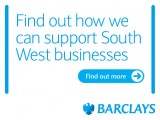Bristol is set to be one of the UK’s fastest-growing cities over the next three years with higher-than-average job creation, new research has revealed.
The city will enjoy annual Gross Value Added (GVA) growth of 2% between 2018-2021 – higher than the UK average of 1.7%, according to international accountancy group EY’s latest Regional Economic Forecast. 
That ranks Bristol alongside Birmingham (also 2%) for growth. It lags slightly behind just two other regional cities – Reading, with a forecast annual growth rate of 2.3%, and Manchester (2.2%). London is not included in the report.
It is the latest in a string of recent studies that have pointed to Bristol’s future economic strength, despite the challenges of Brexit.
The city remains a top target for tech and creative firms looking to move out of London while property investors are following suit due to the overheated market in the capital.
A recent study commissioned by UWE Bristol concluded that the city’s highly talented workforce and unparalleled collaborative approach gave it the potential to become one of the world’s leading centres for innovation.
Such reports back up the plea by the Mayor of Bristol Marvin Rees and the leaders of the UK’s largest cities to devolve more powers and spending away from central government to regional centres, so allowing them to spur further growth.
The EY research shows that employment growth in Bristol, at 0.9%, is also expected to outpace the UK average of 0.5% until 2021 – matching the employment outlook in Reading as the UK’s fastest growing city in GVA growth terms.
The picture is not as bright across the South West as a whole, which experienced a significant slowdown in its economic growth activity in 2018, according to the report. Its 0.8% GVA growth this year compared with 1.7% in 2017.
However, the South West is expected to recapture some ground with its growth rate improving to 1.5% until 2021.
Employment growth in the South West, at 0.4% per year over the period to 2021, will also lag behind the UK rate. Job creation in business services is expected to be partially offset by falling employment in the manufacturing, public administration and defence sectors.
EY South West managing partner Andrew Perkins, pictured, said: “EY’s forecast has identified that city growth typically outpaces regional growth, with Bristol’s GVA and employment growth accelerating to outpace the South West and UK average until 2021.
“Bristol’s growth has been driven by a strong performance in the professional and administration services sectors.
“Whereas in previous reports, the South West, the East and South East have been the fastest-growing regions of the UK, our latest report says these regions have all slowed relative to the rest of the country, with slower growth in the services sector pulling back growth rates in the southern regions.
“In the case of the South West, the region’s weaker GVA performance just strengthens the case for driving deeper geographic rebalancing to maximise the potential of all the UK’s regions. Brexit makes this policy even more important, both to maximise growth but also to support the UK’s transformation to be in a position to prosper after Brexit.”
Other cities with above-average growth rates are Cardiff and Exeter, both with an estimated 1.8%, annual GVA growth rate. Leeds and Luton were also among those forecast to have annual growth rates of 1.8%.
EY’s analysis of eight core cities in the UK (Birmingham, Bristol, Cardiff, Leeds, Liverpool, London, Manchester and Newcastle upon Tyne) reveals growth of 2.2% annually on average between 2015 and 2018, while large towns grew at 1.8%. EY’s forecast expects this distinction to continue with growth rates of 1.8% for core cities and 1.6% for large towns over the next three years.
The UK’s strong performing cities will continue to grow faster than average, however the gap to the slower growing areas will be less than in the recent past with little more than a 1% difference in average annual growth rates between the fastest and slowest growing locations.






























